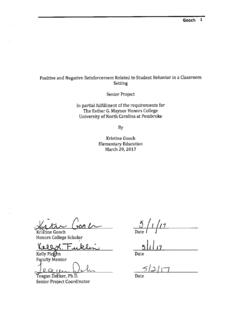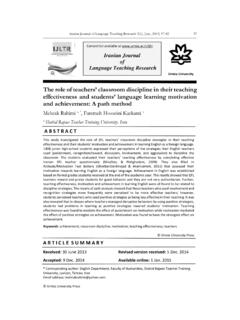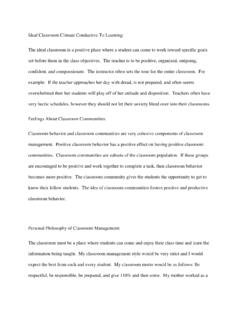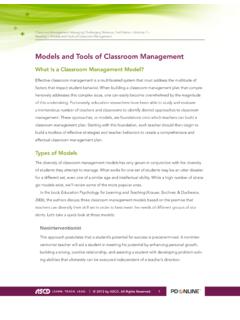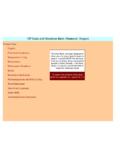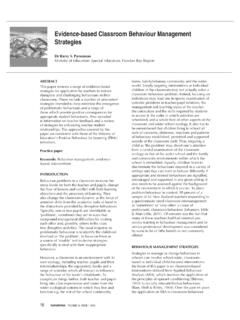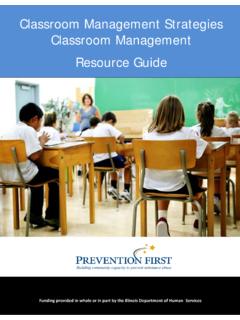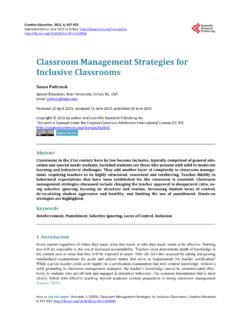Transcription of Classroom Management Approaches to Support School ...
1 Classroom Management Approaches to Support School ConnectednessBehavior ManagementSchool connectedness is the belief held by students that adults and peers in the School care about their learning as well as about them as individuals. Students who feel connected and engaged at School are less likely to report risky behaviors (such as early sexual initiation, substance use, violence, and suicide) and have more positive academic Management is the process that teachers and schools use to create positive Classroom environments in face-to-face or virtual learning modes. Classroom Management includes teacher - and student-led actions to Support academic and social-emotional learning among all Well-managed classrooms that incorporate positive behavior Management strategies are one way that teachers and other School staff can build School Classroom Management Approaches and skills increase connectedness?
2 CDC researchers reviewed scientific papers on Classroom Management and identified six Classroom Management Approaches that promote student connectedness and engagement. Strategies to Support these Approaches were identified through a structured review of web-based practice resources. behavior Management is one of these Management . When teachers provide clear and consistent expectations for behavior in the Classroom and take actions to promote positive, pro-social behaviors, students report a stronger sense of connectedness to School and their ,1 0 Students felt more connected to their peers and School when they reported that:1 Students are given clear instructions about how to do their work in make a point of sticking to the rules in students are acting up in class, the teacher will address it. 4 Students understand consequences for breaking a Management These skills can help promote clear and consistent expectations and effectively manage behavior in the StrategiesGiving students clear instructions about how to do their workClearly communicate to students what they are expected to do to complete their work and why.
3 This includes providing clear (ideally written and oral/recorded) procedures for completing class assignments, turning in homework, and working in virtual learning settings, keep consistent routines, schedules, and methods for participating in remote learning. Consider developing a virtual learning matrix that clearly communicates what is expected of students as they engage in the virtual problematic behavior when it occursUse a strengths focus to Support the development of positive behaviors. For example, create positive Classroom roles for students, such as leading an activity that aligns with their strengths and students who display disruptive behavior develop alternative For example, post key Classroom rules, agreements, and procedures in visible locations as a reminder of class expectations, and emphasize that behaviors are choices that students have control Be mindful of how implicit biases may lead to stereotyping and unfair disciplinary practices, particularly for racial and ethnic minority students who experience disproportionately negative disciplinary virtual settings, consider using virtual tools that provide students with immediate behavioral feedback and reinforcement.
4 Some schools may have software programs that instantly provide students with feedback on their behavior , and allow students to view that feedback through a smartphone app. Alternatively, behavioral feedback can be tracked in a simple spreadsheet or document and constructive feedback can be delivered to students who are not meeting expectations via a one-on-one virtual check StrategiesEnforcing class rules consistentlyBe consistent and predictable when enforcing class rules to eliminate the perception of favoritism and emphasize fairness. Make sure all students receive the same consequences (consistency) every time (predictability) and positively reinforce pro-social behaviors often for all that students understand the consequences of breaking class rulesSet clear, logical consequences for breaking class rules and agreements early on.
5 Be mindful of the difference between logical consequences (which are directly linked to students behavior and focus on corrective guidance and modeling to promote learning and behavior change) and punishment (which focus on short-term compliance).15 Make sure students always have access to the rules and consequences ( , every student gets a copy, posted in the physical Classroom or on an online platform), and consider reviewing the rules and consequences periodically, as virtual classrooms, ensure that students know the positive and negative consequences of their virtual actions. Also, make sure that class rules and consequences are equitable, regardless of students home environment and resources. For example, some students may have unreliable internet service or may not have needed materials or devices for virtual learning, which could make active engagement in lessons and Templates Association for Supervision and Curriculum Development (ASCD).
6 Getting Consistent with Consequences. Center on Positive Behavioral Interventions and Supports (PBIS). Creating a PBIS BehaviorTeaching Matrix for Remote Instruction. Learning for Justice. Reframing Classroom Management : A Toolkit for Teachers. Houghton Mifflin. 10 Virtual Classroom Management Strategies. Responsive Classroom . Punishment vs. Logical Consequences. Reflection NotesHow do I currently do this? What could I do to improve?References1. Steiner RJ, Sheremenko G, Lesesne C, Dittus PJ, Sieving RE, Ethier KA. Adolescent connectedness and adult health outcomes. Pediatrics. 2019;144(1).2. Marraccini ME, Brier ZM. School connectedness and suicidal thoughts and behaviors: A systematic meta-analysis. School Psychology Quarterly. 2017;32(1) Niehaus K, Rudasill KM, Rakes CR. A longitudinal study of School connectedness and academic outcomes across sixth grade.
7 Journal of School Psychology. 2012;50(4) Carter M, McGee R, Taylor B, Williams S. Health outcomes in adolescence: Associations with family, friends and School engagement. Journal of adolescence. 2007;30(1) Griffiths A-J, Lilles E, Furlong MJ, Sidhwa J. The relations of adolescent student engagement with troubling and high-risk behaviors. Handbook of research on student engagement: Springer; 2012. p. Lei H, Cui Y, Zhou W. Relationships between student engagement and academic achievement: A meta-analysis. Social behavior and Personality: an international journal. 2018;46(3) Evertson CM, Weinstein CS. Classroom Management as a field of inquiry. Handbook of Classroom Management : Research, practice, and contemporary issues. 2006;3(1) Hawkins JD, Guo J, Hill KG, Battin-Pearson S, Abbott RD. Long-term effects of the Seattle Social Development Intervention on School bonding trajectories.
8 Applied developmental science. 2001;5(4) Gest SD, Madill RA, Zadzora KM, Miller AM, Rodkin PC. teacher Management of elementary Classroom social dynamics: Associations with changes in student adjustment. Journal of Emotional and Behavioral Disorders. 2014;22(2) Acosta J, Chinman M, Ebener P, Malone PS, Phillips A, Wilks A. Understanding the relationship between perceived School climate and bullying: A mediator analysis. Journal of School violence. 2019;18(2) Taylor JC. Seven Classroom structures that Support student relationships. Published Center on Positive Behavioral Interventions and Supports. Responding to the novel coronavirus (COVID-19) outbreak through PBIS. Published 2020. Accessed September, Skiba RJ, Arredondo MI, Williams NT. More than a metaphor: The contribution of exclusionary discipline to a School -to-prison pipeline.
9 Equity & Excellence in Education. 2014;47(4) SchoolMint. PBIS in a virtual environment. Published 2020. Accessed September, Responsive Classroom . Punishment vs. logical consequences. Published 2011. Accessed September.










